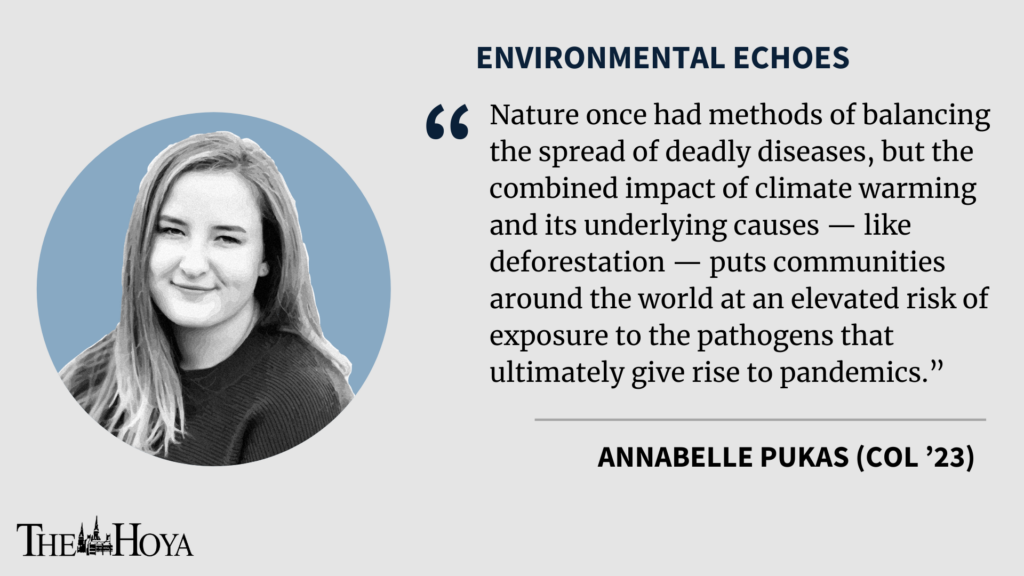The COVID-19 pandemic has completely upended life as we once knew it, infecting over 104 million people and claiming the lives of over 2.2 million worldwide. While the current vaccine rollout makes the prospect of life returning to normal seem just on the horizon, inaction toward the climate crisis may have communities reliving the pandemic experience all too soon.
Nature once had methods of balancing the spread of deadly diseases, but the combined impact of climate warming and its underlying causes — like deforestation — puts communities around the world at an elevated risk of exposure to the pathogens that ultimately give rise to pandemics.
Healthy habitats and biodiversity were once one of nature’s primary checks against the spread of deadly diseases. Unfortunately, the world has seen massive land use changes and deforestation at the hands of humans. At this point, humans have significantly altered 75% of the land and 66% of the ocean. While forests provide invaluable ecosystem services such as carbon sequestration and air purification, only 15% of the world’s forests remain intact; the rest have been cut down, degraded or massively fragmented.
Current rates of habitat loss are driving the unravelling of life on Earth, causing species to go extinct at rates unknown since the age of the dinosaurs. Around one million species are at risk of going extinct within the next decade. These human-made changes are significant because the stress placed on biodiversity is the most common driver of infectious disease emergence, accounting for approximately one-third of all emerging disease events, according to a 2015 study.
Anthropogenic climate change as a whole also results in the loss of biodiversity and viable habitats. Hotter-than-usual climates drive species away from their historical territories and toward the poles in search of a cooler climate. These migrations not only increase the likelihood of new species coming into contact with each other, allowing diseases to find new vectors, but they also drive new diseases into urban areas. For example, epidemiologists estimate that almost 1 billion people in developed areas like Europe and North America could be exposed to mosquito-borne diseases like dengue fever, Zika and chikungunya for the first time by 2080.
While much of the science linking pandemics with climate change is predictive, the destruction of natural ecosystems has already made the conditions associated with the spread of Ebola, Lyme disease, malaria and dengue fever more favorable. Both governments and individuals must take action now in order to minimize the potential for human exposure to any number of the 1.7 million potentially harmful viruses circulating in animal populations.
For governments, the most economically viable solution is to address climate change and invest in pandemic prevention and response strategies. The cost of risk reduction to prevent pandemics is 100 times less than the cost of responding to such pandemics, according to UNESCO, and a major component of reducing the prevalence of infectious disease is protecting and restoring ecosystems and their endemic biodiversity.
Further, the continuous epidemiological monitoring of communities that exist on the edge of wild spaces is vital. These programs involve scientists surveying communities and tracking their potential exposure to zoonotic diseases, which could stop deadly viruses early, halting them in their tracks before they migrate into urban spaces.
People, for their part, must assume responsibility in the ways they can. Primarily, we should reduce our consumption of animal products when possible, as recommended by Dr. Aaron Bernstein, director of Harvard Chan Center for Climate, Health, and the Global Environment. The impact of these choices is twofold: First, reducing meat and palm oil consumption directly minimizes support for deforestation, as the two products are primarily responsible for 85% of the global deforestation associated with the agricultural industry. Second, reduced consumption of animal products greatly lowers production demands and, by extension, the potent greenhouse gases emitted by the animals.
Ultimately, we must reflect on the COVID-19 pandemic and realize that, in regards to climate change and deadly outbreaks, an ounce of prevention is worth a pound of cure. As Dr. Bernstein concludes on the topic, “I can tell you that we need to wash our hands and we need to socially distance. But if we really care about preventing this kind of problem in the future, we need to think hard about climate change and the biodiversity crisis.” Now is the time for governments and individuals alike to recognize that, without change, our world with COVID-19 is only a glimpse into our future.
Annabelle Pukas is a sophomore in the College. Environmental Echoes appears online every other Friday.










Ted & Kathi Pukas • Feb 5, 2021 at 5:31 pm
Outstanding, Annabelle!!!! I’ve shared this with the people I most love. Mom/mom